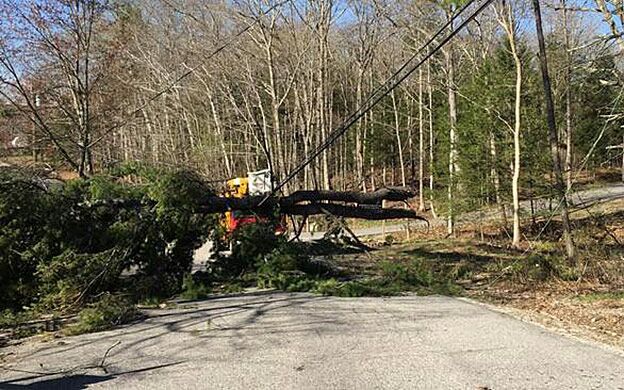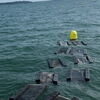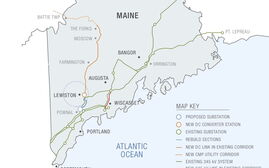
Processing Your Payment
Please do not leave this page until complete. This can take a few moments.
- News
-
Editions
View Digital Editions
Biweekly Issues
- December 1, 2025
- Nov. 17, 2025
- November 03, 2025
- October 20, 2025
- October 6, 2025
- September 22, 2025
- + More
Special Editions
- Lists
- Viewpoints
-
Our Events
Event Info
Award Honorees
- Calendar
- Biz Marketplace
AVANGRID's $2.5B plan to boost storm 'resiliency' in Maine, Northeast
 Courtesy / Central Maine Power
High winds caused this tree to come down across Central Maine Power Co.'s utility lines in Lebanon, Maine during last October's major wind storm. CMP's parent company, AVANGRID Inc., announded today it plans to spend up to $2.5 billion to improve the resiliency of its power grid in Maine, Connecticut and New York to minimize the impact severe storms will have in the future.
Courtesy / Central Maine Power
High winds caused this tree to come down across Central Maine Power Co.'s utility lines in Lebanon, Maine during last October's major wind storm. CMP's parent company, AVANGRID Inc., announded today it plans to spend up to $2.5 billion to improve the resiliency of its power grid in Maine, Connecticut and New York to minimize the impact severe storms will have in the future.
AVANGRID Inc. (NYSE: AGR), parent company of Central Maine Power Co., announced today that its networks division is developing a comprehensive $2.5 billion plan to address the impact severe storms have on infrastructure throughout its utilities’ service territories in Maine, Connecticut and New York.
The plan includes measures that will harden the power grid to better withstand storms while also utilizing technology that will help customers better manage their energy consumption, the Connecticut-based company stated in a news release.
“The frequency and severity of storms continues to increase, and recent storms have packed a powerful punch, inflicting serious damage to electrical infrastructure,” the release stated. “AVANGRID is committed to meeting this challenge head-on by investing in solutions to mitigate the hardships these storms impose on our customers.
Robert Kump, CEO of Avangrid Networks, said in just the past 16 months, the company’s utilities in Maine, New York and Connecticut incurred more than $450 million in storm damage and restoration costs.
“As these weather patterns become the new norm, it is imperative that we implement a long-term plan to harden our grid and help ensure that our customers experience the level of reliability they expect from their energy company regardless of the weather,” he said.
Here's what's planned

Under the plan, AVANGRID anticipates investing about $2.5 billion over the next 10 years. This includes an existing $500 million proposal in New York for the full rollout of Automated Metering Infrastructure by Rochester Gas and Electric Corp. and New York State Electric & Gas.
AMI, often referred to as “smart meters,” is already in place in CMP’s service region and United Illuminating in Connecticut.
Avangrid stated that smart meter systems provide numerous benefits, including faster response to storm restoration and the ability for customers to better manage their energy use through access to hourly usage data. Customers can also participate in innovative rate options and take advantage of other smart solutions in their homes.
Key elements of AVANGRID’s “Transforming Energy” plan include:
- Accelerated replacement of wood poles based on a specific list of criteria including physical condition, structural deficiencies and recent circuit performance.
- Increased use of insulated spacer cable or “tree wire” to minimize outages in the instance of tree contact;
- An analysis of areas where electrical infrastructure hardening, including undergrounding or new technologies such as batteries or microgrids, would save money based on circuit performance.
- More aggressive “ground to sky” tree trimming and the identification and remediation of hazardous trees outside the right-of-way along critical infrastructure;
- Targeted distribution circuit upgrades to improve grid structure to minimize impact and provide alternative sources of supply to speed up restoration flexibility.
- Full implementation of Automated Metering Infrastructure to provide its energy companies with greater visibility to identify issues during storms faster.
In addition to CMP’s territory, the plan will be implemented in the service territories for Rochester Gas and Electric Corp. and New York State Electric & Gas. The extent and scope of hardening and remediation efforts will differ by company based on each company’s specific needs and criteria, and will require regulatory approval, the news release stated.
“As we develop our plan, a key focus will be on tree-related interruptions, which are the leading cause of outages,” Kump added. “Eighty percent of storm-related outages are caused by trees, over half of which are outside of our right-of-way. That’s why we will look to improve our vegetation management protocols, working collaboratively with local municipalities, public works entities and individual customers to tackle potential problems both inside and outside of our right-of-way.”
The company stated at it will refine and fine-tune the plan in the months ahead, a process that includes analyzing financial and workforce requirements to implement it.
“We are committed to meeting our customers’ expectations, and will work closely with regulators and elected officials in the states where we operate, to ensure our plan advances that objective in a cost efficient manner,” Kump said.
Mainebiz web partners
Related Content

The Giving Guide
The Giving Guide helps nonprofits have the opportunity to showcase and differentiate their organizations so that businesses better understand how they can contribute to a nonprofit’s mission and work.
Learn More
Work for ME
Work for ME is a workforce development tool to help Maine’s employers target Maine’s emerging workforce. Work for ME highlights each industry, its impact on Maine’s economy, the jobs available to entry-level workers, the training and education needed to get a career started.
Learn More
Groundbreaking Maine
Whether you’re a developer, financer, architect, or industry enthusiast, Groundbreaking Maine is crafted to be your go-to source for valuable insights in Maine’s real estate and construction community.
Learn more-
The Giving Guide
The Giving Guide helps nonprofits have the opportunity to showcase and differentiate their organizations so that businesses better understand how they can contribute to a nonprofit’s mission and work.
-
Work for ME
Work for ME is a workforce development tool to help Maine’s employers target Maine’s emerging workforce. Work for ME highlights each industry, its impact on Maine’s economy, the jobs available to entry-level workers, the training and education needed to get a career started.
-
Groundbreaking Maine
Whether you’re a developer, financer, architect, or industry enthusiast, Groundbreaking Maine is crafted to be your go-to source for valuable insights in Maine’s real estate and construction community.
ABOUT
NEW ENGLAND BUSINESS MEDIA SITES
No articles left
Get access now
In order to use this feature, we need some information from you. You can also login or register for a free account.
By clicking submit you are agreeing to our cookie usage and Privacy Policy
Already have an account? Login
Already have an account? Login
Want to create an account? Register
Get access now
In order to use this feature, we need some information from you. You can also login or register for a free account.
By clicking submit you are agreeing to our cookie usage and Privacy Policy
Already have an account? Login
Already have an account? Login
Want to create an account? Register










Comments